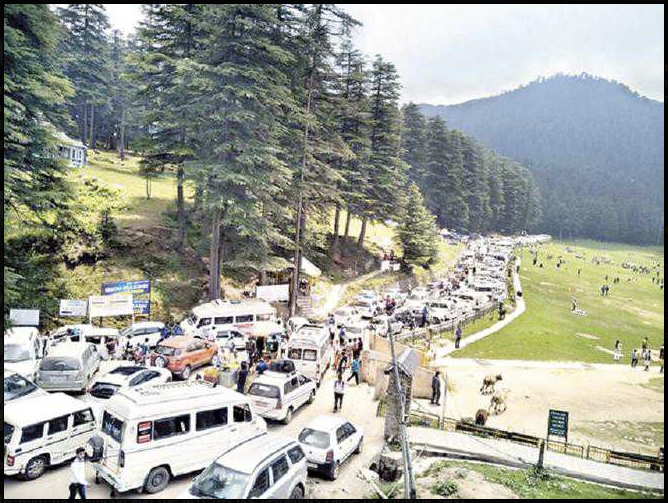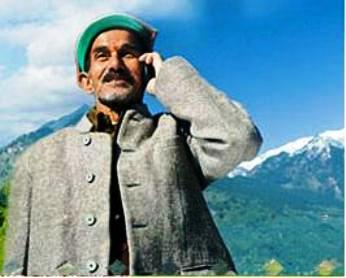I was aghast to see a photograph in the Tribune about two weeks back of a long traffic jam in Khajjiar in Chamba – the line of vehicles in this exquisite dale was at least a kilometer long! The SDM Dalhousie further informed the reporter that during the season about 5000 vehicles go to Khajjiar every day. Two days later it was reported that 1000 tourists go to Triund (above Mcleodganj) every day. What are we doing to our few remaining natural features ?
Rohtang pass has become a by-word for pollution and the NGT has not helped its cause by allowing 1400 vehicles there everyday. Now that the state govt. has introduced electric buses for the pass, NO OTHER VEHICLES should be allowed (except for genuine travellers to Leh, Kaza and other places beyond the pass). The NGT should not succumb to pressures from the unholy nexus of hoteliers and taxi unions- their livelihoods (based on extortion of tourists, mostly) are not more important than the preservation of our natural heritage for future generations. No new taxi permits should be issued for Manali sub-division – it already has more than the area can support. Nor should permits for new hotels be sanctioned: Manali already has more hotel beds than Delhi ! And whatever happened to the rope-way from Palchan to Rohtang- the tenders were first floated way back in 2010 and it should have been up and running in three years. The NGT’s local Commissioner in Manali, Mr. RakeshwarLal Sood, should monitor its progress with greater urgency, for ultimately this is what will save the Rohtang from the internal combustion engine and the external combustion lobbies.

Coming back to Khajjiar, I’ve been there more times than I can remember and never sighted more than a couple of vehicles there. Even though the lake itself must have disappeared by now (every govt. department has tried to arrest its siltation, and with each such intervention it has become smaller!) the glade or vale or meadow is a thing of beauty, unsurpassed even in this state blessed by nature and cursed with commerce. The very idea of 5000 vehicles and 20000 chhola bhatura type of tourists running amok there is a blasphemy. The question, therefore, is: what is the govt. or the district administration doing about controlling this polluting flood ? Obviously, nothing, or we wouldn’t have so many vehicles there in the first place. Why should we always be passive, indifferent and safe, waiting for the NGT or the High Court to do something to stem the rot rather than take the initiative ourselves ? Why do we get fat 7th Pay Commission salaries ? Why are we always silent in the face of pressures from politicians, taxi drivers, bus operators, hoteliers and tourists who have destroyed their own cities and are now hell bent on ravaging what is rightfully our heritage? Cannot the state Forest department, which has more PCCFs, Addl. PCCFs and CCFs than we have wild life in our forests, be more proactive and visionary in protecting places like Khajjiar and Triund ?
To my mind, the first thing to be done is to assess the carrying capacity of these places and restrict the number of visitors to that number. Secondly, impose a COMPLETE BAN on private or commercial vehicles going to Khajjiar. Instead acquire a few electric buses for the purpose as is being done for Rohtang. Third, erect barriers and do not allow any form of plastic to be taken to either of these places, not even PET bottles. Four, impose a heavy user fee for the visit ; if these urbanites can pay five hundred rupees at a multiplex to see the curves of Rakhi Sawant they should not mind paying a similar amount to view the undulations of our mountains and valleys – which, incidentally, are completely natural. Such restrictions are even more necessary for Triund which at 9000 feet is close to the snow line and has no water- garbage and human waste are the biggest threats to its pristine grandeur. I’ve been there at least thrice (which I remember) and can state with all confidence that it cannot support more than 50 visitors a day. No night stay should be permitted there, in order to avoid generation of more human waste. There were no structures there a few years ago, except a Forest Rest House and a much needed tea stall a kilometer below it, but I now read that a number of dhabas etc. have come up there now. This is nothing but sheer laxity, negligence if not collusion of the forest and revenue officials, for all land there is forest land. They should be demolished immediately lest it become another Marhi. There was also a proposal to build a ropeway from Mcleodganj/Dharamshala to Triund, primarily to kill another daft idea: build a road to Triund! The technical and financial feasibility reports were ready eight years ago, so why this delay?
Unplanned mass tourism and excessive “development” are ravaging Himachal’s natural environment and assets. Mr. Virbhadra Singh’s roads and Mr. Dhumal’s hydel projects have already devastated most of the natural beauty of the state; let us at least make an honest effort to save the few blessed places that remain. There has to be a vision beyond money, votes and the Apex scale.
| The author retired from the IAS in December 2010. A keen environmentalist and trekker he has published a book on high altitude trekking in the Himachal Himalayas: THE TRAILS LESS TRAVELLED.
His second book- SPECTRE OF CHOOR DHAR is a collection of short stories based in Himachal and was published in July 2019. His third book was released in August 2020: POLYTICKS, DEMOCKRAZY AND MUMBO JUMBO is a compilation of satirical and humorous articles on the state of our nation. His fourth book was published on 6th July 2021. Titled INDIA: THE WASTED YEARS , the book is a chronicle of missed opportunities in the last nine years. Shukla’s fifth book – THE DEPUTY COMMISSIONER’S DOG AND OTHER COLLEAGUES- was released on 12th September 2023. It portrays the lighter side of life in the IAS and in Himachal. He writes for various publications and websites on the environment, governance and social issues. He divides his time between Delhi and his cottage in a small village above Shimla. He blogs at http://avayshukla.blogspot.in/ |




Sir your predicaments are genuine but shall never fall rich on the deaf “ears” of the all those who matter to take it in a positively.I am afraid that very soon you shall be blacklisted for your proactive environment concerns.
I’m posting these comments received by me today on my mail for sharing with the readers of HILLPOST. Suman Dube is an environmentalist, an ardent trekker and a noted mountaineer who has been to South Col. on Mount Everest. He has trekked extensively in Himachal, as his comments indicate too. He is associated with THE HIMALAYAN JOURNAL. Avay Shukla.
Dear Avay,
I’m glad you’ve focused on these issues. In 2005 I was returning from beyond Bara Lacha and found myself trapped in a traffic jam just across Rohtang on its Manali side. I just got out of the vehicle and walked down to Kothi. The path, which my parents took up from the Kothi rest house in 1951 — was in disrepair. In any other country in the world it would be a well maintained and well used trail by the young and old alike. My vehicle didn’t return till late night! I haven’t been back since. I’ve often thought that they should simply ban cars, and that should be possible once the tunnel is done. A cable car and a well-maintained path is what could do the trick. But who knows. In 1997 I walked to Chandra Tal but now it probably looks like Khajjiar!
In contrast, here’s a link to a video I shot in the north of the Pangi region bordering on Ladakh. I hope roads haven’t ingressed into those valleys. I have been lucky to have seen the mountains in their pristine condition, before the China problem caused roads to be built (my father was the first DGBR who set up the organisation in 1960 — but he respected the mountains and did a lot of his recce work on foot.) As for what is happening to the pilgrimage destinations…. Hemkund is a good example. Although you still have to walk the steep trail, the shrine has become a festive destination with all the associated pollution and natural destruction. Attached is what it looked like in 1966 — a small shrine and the frame of a gurdwara inhabited in the summer months — contrasted with what they’ve built there now (this is from the internet — I wouldn’t want to be there!)
I did the Amarnath yatra in 2002 and saw what tens of thousands can do to the trail and countryside. The yatra has been extended since then and the numbers have increased exponentially — the shit alone makes it almost unbearable!
Keep writing….
Suman
https://youtu.be/JHykFINE
It is clear that the mass tourism juggernaut is unstoppable. The question is how can we minimize its negative impacts? A few options come to mind. All will require funds and more so political will to fight vested interests. Is that asking for too much?
1. DIVERSIFY: Himachal needs to open up more areas of tourist interest, especially where trekking is involved. Prime areas (illustrative) could include, the Tirthan and Sainj valleys around the GHNP in Kullu; the Barot valley in Jogindernagar to Lag valley in Kullu treks (partly motorable); the Khirganga/ Pulga area in Parvati valley; the forest bridle paths circuit in Chopal; organised treks of various difficulty inside wildlife sanctuaries.
2. Professionalise Eco-tourism: with a network of several hundred forest rest houses (mostly unused) and many PWD/IPH rest houses, the essential infrastructure for a big eco-tourism network is already there. Government needs to get in professional operators to make this into a thriving and sustainable tourism opportunity.
3. Individual cars can be highly taxed and smaller buses much less so.
4. The home stay policy should be liberalised and made free of the bureaucracy.
5. Selling beer should not require any license, like wine.
6. Efficient systems of garbage disposal and hygiene in place along highways.
7. Provide much better high speed Internet access all over the state.
8. Press for 2 or 3 luxury trains on its narrow gauge railways.